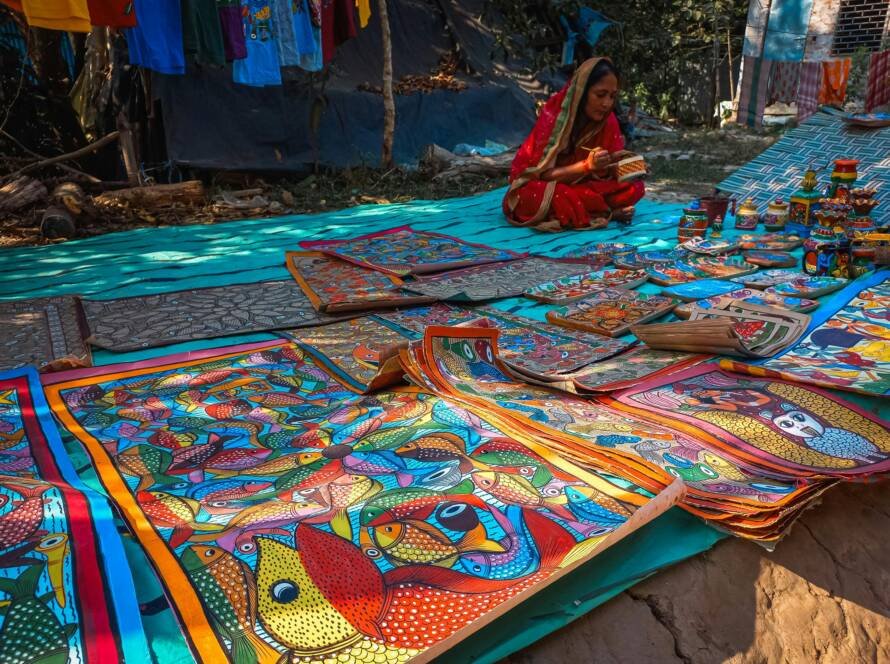A Thread Through Time
There’s something ineffably comforting about a grandmother’s quilt—each stitch a memory, each patch a whisper from the past. Like an old lullaby passed from mother to child, India’s crafts are not merely objects of beauty; they are vessels of memory, emotion, identity, and belief. In the folds of a handwoven sari, in the gentle beat of a loom, in the glint of a mirror on embroidered cloth—there lie stories untold and values deeply held.
Crafts in India are more than decoration; they are storytelling in its most tactile form. They preserve not just techniques but entire worldviews, passed from calloused hands to eager ones, across generations. This is a journey through those living traditions—a tribute to the way our crafts continue to shape who we are and what we value.
Craft as Cultural Memory
In tribal villages and temple towns, the hands of artisans carry centuries of inherited wisdom. The Warli painter, for instance, does not just paint figures on walls—she narrates the cycle of life and the community’s harmonious bond with nature. The potter doesn’t merely mold clay but shapes fertility, festivity, and function into form.
Crafts like Madhubani painting, Pattachitra, or Phad scrolls are not isolated artforms—they are oral histories, rituals, and community chronicles. Every motif, every symbol—be it a peacock, tree of life, or lotus—holds a coded message. These are not just aesthetic choices; they are reflections of cultural philosophies, gender roles, spiritual beliefs, and ecological awareness.


Skills Passed Through Silence
In artisan homes, there’s often no formal classroom, no textbooks. The learning is through doing. A child watches her father carve wood or her mother embroider fabric—not through instruction, but by osmosis. Each movement is absorbed like a lullaby hummed repeatedly. Precision, patience, and pride become second nature.
This quiet, generational transmission is perhaps the most powerful pedagogy—where skill is sacred and every mistake is met with wisdom, not correction. The techniques—dying, weaving, casting, painting—are guarded like sacred mantras, evolving but never losing their roots. In this, crafts echo the Indian philosophy of guru-shishya parampara—learning through presence, immersion, and reverence.
Crafts as Mirrors of Social Values
Our crafts speak of more than beauty—they reflect how communities think and relate. Bamboo and cane work speaks of sustainability; Kantha stitch speaks of frugality and repurposing; Toda embroidery speaks of identity and resistance; and Kalamkari reflects myth and moral inquiry.
Crafts are also deeply gendered and social. In some communities, it is the women who sustain traditions like weaving or pottery, nurturing them like their own children. In others, it is men who create sacred bronzes or ritual scrolls. Through it all, craft acts as a glue—binding families, sustaining livelihoods, reinforcing traditions, and fostering a deep sense of dignity.
Why It Still Matters Today
In an age of mass production, the slow, deliberate act of handcrafting is a radical reminder of humanity. It invites us to be mindful, rooted, and connected to the earth, to each other, and to ourselves. Owning a piece of craft is not merely an act of consumption—it is an act of preservation and participation in a larger cultural memory.
Crafts also offer a gentle protest against cultural erasure. As traditions risk fading under the pressures of modernity, revival efforts—led by artisans, designers, and cultural custodians—breathe life back into these artforms, helping them remain relevant, sustainable, and respected.
A Gentle Invitation
Let us not look at crafts as souvenirs, but as stories waiting to be listened to. Let us pass on not just objects, but the values they carry—of harmony, humility, patience, and pride. When we support a craft, we are not just supporting an artisan—we are honoring an entire way of life, rooted in rhythm, ritual, and resilience.
In every knot tied, color mixed, thread pulled, and form shaped—there is an echo of the past and a promise to the future. All we need to do is pause, listen, and let it speak to our hearts.



